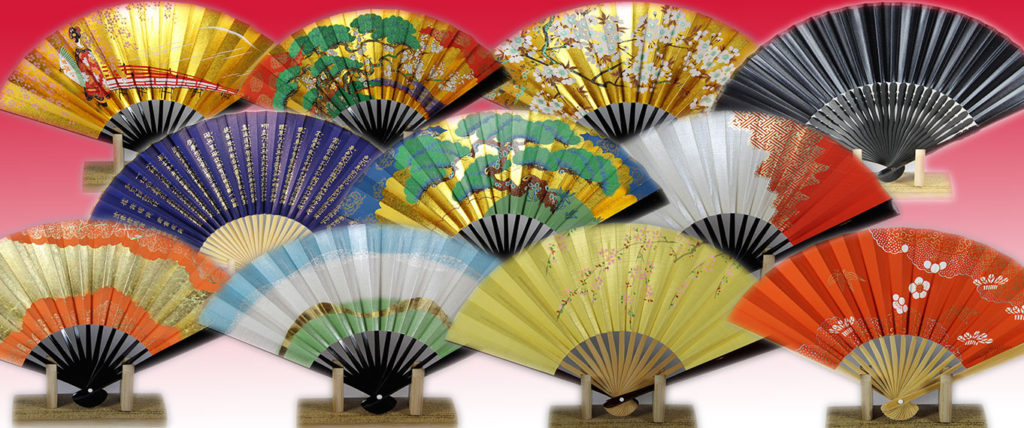
First originating in the early years of the Heian period (794 - 1185 AD), Japanese folding fans have played an important role in Far Eastern society for centuries. Sensu, as they are natively known, were traditionally used during ceremonies, ancient rituals and for decorational purposes. Folding fans are still very popular in Japan today, although they are now primarily used to fan oneself in hot and humid weather.
Japanese fans are usually made from paper or cloth on a collapsible bamboo frame. Many designs are adorned with decorative motifs such as floral designs or geometric patterns. The angle the fan is opened to varies between 90 and 180 degrees, with around 120 degrees being the norm. The shape of the unfolded fan broadens towards the ends, a shape known in Japanese as “Sue-hirogari”.
Varieties of Sensu
Folding fans take their name from the area in which they are made. For instance, those originating in Kyoto around 1,200 years ago are known as “Kyo-sensu”. In comparison, those made in Edo (present day Tokyo) are known as “Edo-sensu”. Within these regional categories, there are several different types of sensu:
Hi-ougi is the oldest style of Japanese folding fan. Traditionally used in ceremonies by Shinto priests and Imperial Court ladies, the fan uses thin slats of cypress wood that are stitched together with silk thread. Hi-ougi are often decorated with symbols of the natural world such as butterflies and birds.
Kawahori-sen are decorative paper fans that evolved from Hi-Ougi during the Heian period. Japanese Kawahori-sen have one-side glued with paper, while the Chinese variation is two-sided.
Cha-sen are traditionally used in the Japanese tea ceremony, known natively as Chanoyu. This type of sensu comes in two different sizes, one for each gender. Male cha-sen usually measure around 18cm, while those for women measure about 15cm.
Mai-ougi are used in Japanese dance and Kabuki, a type of theatrical performance art. Similarly to cha-sen, there are subtle differences in the design of male and female mai-ougi, usually in relation to their colour or size.
Gun-sen are a type of iron and bamboo fan exclusive to military commanders. Also known as Japanese war fans, this style was used by the samurai class of feudal Japan. As well as using them to cool off, commanders would use gun-sen as a signalling device, a form of defence and, in extreme cases, a weapon.
How to make a Japanese folding fan
The history of the Japanese folding fan
While the exact date of the folding fan’s invention remains unknown, the first sensu came into existence in Kyoto around 1200 years ago. These were typically made in Hi-ougi style, although at the time of their conception they were not used as a cooling device, but as a communication tool.
Paper was a very precious commodity at the time, so monks and public officials would write notations on slender strips of wood. These wooden strips were often joined together to form a wooden notebook of sorts. Soon after, the practice of drawing pictures on the strips became commonplace. They came to be used by both men and women, nobles and princesses. In Japan, there are many examples of fans containing important information such as rules, court orders, announcements, calendars, prayers, medical transcriptions and maps.
During the mid-Heian period, the use of paper began to spread. By now, sensu were used as popular cooling devices. Kawahori-sen were introduced for specific use in the summer, compared to to Hi-ougi typically employed during the winter.
Japan’s economy was boosted in the 15th century when they began exporting their fans to China. This soon spread to Europe and America, which instigated the rise of professional fan painters and factories in areas such as Kyoto. Those fans that found their way to Europe were re-imported towards the end of the Edo period in the form of Kinu-sen – a variety of sensu made from tightly stretch cloth.
After Japanese ports reopened to trade with the West in 1854, sensu and other oriental objects began pouring into Europe. European women of all social classes began carrying folding fans as a decorative yet practical accessory. This was often exhibited in the work of many renowned French Impressionists who were heavily influenced by Japonisme.
These days, demand for more fashionable sensu has soared with different designs, colours and patterns being developed to fit in with the modern market. Many folding fans are now printed with characters from popular culture. Regardless of age or sex, a lot of visitors to Kyoto buy Kyo-sensu as souvenirs, both for their beauty, and because they are very compact and easy to carry.
Japan Craft stocks a wide range of folding fans in a variety of colours, styles and sizes.




